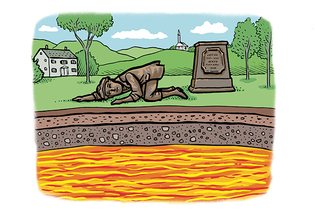 loading
loading
FindingsA volcano? In New England? Well . . . no.But there is a bubble of hot rocks down there.  Gregory NemecView full imageIf Hollywood made a movie about Maureen Long’s study of an upwelling of hot rock under central New England, no doubt the trailer would begin: Be afraid. Be very afraid. But Long, a professor of geology and geophysics who uses waves generated by earthquakes to analyze the Earth’s inner structure, finds that idea amusing. “My mom lives in New Hampshire,” she says. “I told her not to sell the house.” Yet. Long and colleagues at Yale and Rutgers used new data from a network of ultrasensitive seismometers placed throughout the region by the National Science Foundation’s EarthScope project. One result from EarthScope is a kind of CT scan of the Earth’s upper mantle—the band of mostly solid rock, some 250 miles deep, that underlies the planet’s relatively thin crust. The team examined an anomaly that had been found 65 to 100 miles beneath the surface: a bubble of hot rocks hundreds of degrees warmer than the rock around them. (The work was published in Geology.) “There’s this region underneath central New England where seismic wave speeds slow down,” says Long, explaining that it’s a sign of higher temperatures. “We used a technique called seismic anisotropy to tell us the way the mantle was flowing.” Typically, mantle flow under New England is east to west, but within the anomaly, the scientists found something strange: “The east-west signal went away.” Instead, “we saw evidence for weak or absent horizontal mantle flow.” That implies the bubble is rising. But don’t lose sleep, says Long. “There’s no certainty that the upwelling region will ever reach the base of the crust and cause volcanism. Even if it does, that time would be tens of millions of years from now—not, say, next Wednesday.”
The comment period has expired.
|
|